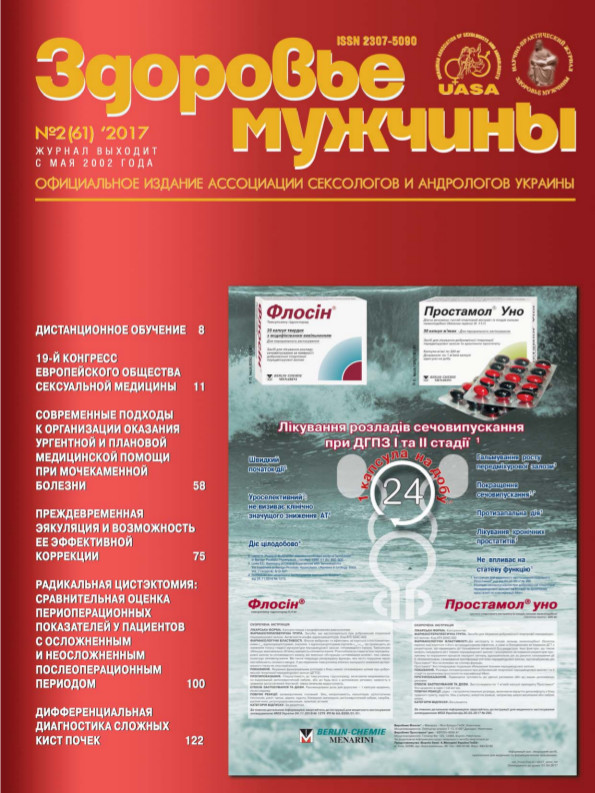Dialysis and a urinary tract infection in patients with autosomal dominant polycystic kidney disease
##plugins.themes.bootstrap3.article.main##
Abstract
The objective: was to determine the effect of infectious complications and their treatment in patients with polycystic kidney disease on performance indicators peritoneal dialysis. Patients and methods. We conducted clinical and laboratory examination of 92 PD-patients, 13 of whom suffered from polycystic kidney disease. The effectiveness of PD was assessed by azotemia, blood pressure, hemoglobin, serum iron, ferritin, transferrin, total protein and albumin of blood serum, the electrolytes, indicators of calcium and phosphorus and lipid metabolism.
Results. Adequate antibiotic therapy and, if necessary, surgical intervention allowed to continue renal replacement therapy method of peritoneal dialysis, improving the indicators of its efficiency, to reduce the frequency of hospitalizations.
Conclusions. Despite the frequency of infectious complications in PD-patients with polycystic kidney disease, timely sanation of infection foci provides the possibility a lengthy and adequate renal replacement therapy.
##plugins.themes.bootstrap3.article.details##

This work is licensed under a Creative Commons Attribution 4.0 International License.
Authors retain the copyright and grant the journal the first publication of original scientific articles under the Creative Commons Attribution 4.0 International License, which allows others to distribute work with acknowledgment of authorship and first publication in this journal.
References
Алиев Р.А. Роль этиологических и других факторов в развитии хронической почечной недостаточности / Алиев Р.А. // Нефрология и диализ. - 2001. – Т. 3, No 1. – С. 358–364.
Андреева Э.Ф. Аутосомно-доминантный и аутосомно-рецессивный поликистоз почек / Андреева Э.Ф., Ларионова В.И., Савенкова Н.Д. // Нефрология. – 2004. – Т. 8, No 2. – С. 7–13.
Возіанов С.О. Первинна, загальна захворюваність, смертність від основних хвороб органів сечостатевої системи в аспекті діяльності ДУ «Інститут урології НАМН України / С.О. Возіанов, Н.О. Сайдакова, В.М. Григоренко, А.П. Онищук, О.О. Ониськів // Урологія. – 2015. – Т. 19, No 3. – С. 15–28.
Дюк К.А. Кистозная болезнь почек / К.А. Дюк, В.М. Беннет // Руководство по нефрологии: Пер. с англ. Под ред. Дж.А. Витворт, Дж.Р. Лоренса. – М.: Медицина, 2000. – С. 277–289.
Колесник М.О. Етіологічний спектр та десятирічний патерн антибактеріальної резистентності збудників неускладненої інфекції сечової системи (2005–2015 роки) / Колесник М.О., Степанова Н.М., Кругліков В.Т. // Український журнал нефрології та діалізу. – 2016. – No 1 (49). – С. 32–41.
Магарщак О.О. Современные подходы к иммунопрофилактике инфекций у пациентов с заболеваниями почек / Магарщак О.О., Шавырин А.А. // Нефрология и диализ. – 2001. – Т. 3, No 1. – С. 24–28.
Пасечников С. П. Мониторинг видового спектра возбудителей инфекций мочевыводящих путей и их чувствительности к антибактериальным препаратам в урологическом отделении / С.П. Пасечников, Н.А. Сайдакова, В.С. Грицай, В.В. Кузнецов // Урологія. – 2011.– No 2 (57). – С. 9–16.
Disney A.P.S. Some trends in chronic renal replacement therapy in Australia and New Zealand 1997 / Disney A.P.S. // Nephrol. Dial. Transplant. – 1998. – Vol. 13. – P. 854–859.
Drognitz O. Kidney transplantation with concomitant unilateral nephrectomy: a matched-pair analysis on complications and outcome / Drognitz O., Kirste G., Schramm I. [et al.] // Transplantation. – 2006. – Vol. 81. – No 6. – Р. 874–880.
Ellis D. Avner, Richard P. Woychik. Cellular pathophysiology of cystic kidney disease: insight into future therapies. Case Western Reserve University, Clevelend, USA, 1999.
Elzinga L.W. Cyst decompression surgery for autisomal dominant polycystic kidney disease / Elzinga L.W., Barry J.M., Torres V.E. [et al.] // J Am Soc Nephrol. – 1992. – Vol. 2. – P. 1219–1226.
Rutkowski B. Chahging patient of end-stage renal disease in Central and Eastern Europe / Rutkowski B. // Nephrol. Dial. Transplant. – 2000. – Vol. 15. – P. 156–160.
Watson M.L. Complications of polycystic kidney disease / Watson M.L. // Kidney Int. – 1997. – Vol. 51. – P. 353–365.





